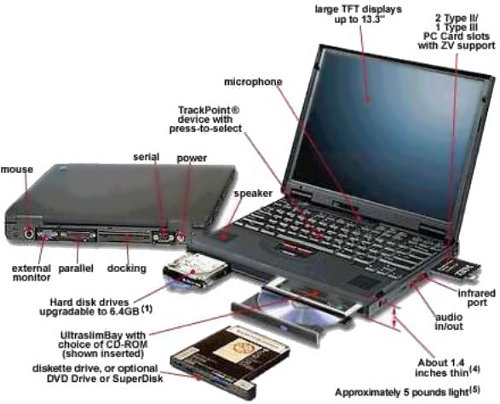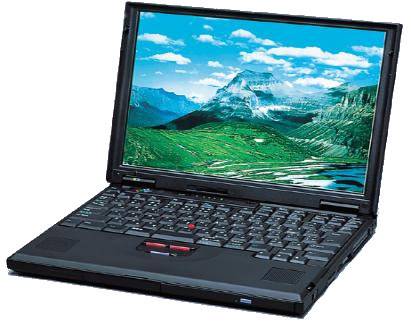Installing PCLinuxOS-LXDE on IBM Thinkpad 600e
by Hootiegibbon
A couple of weeks ago, I was very fortunate to acquire a Pentium II IBM ThinkPad. At the time, the ThinkPad was in a poor state. The HDD was missing, it had no hard drive caddy, and the hard drive cover was missing. It was also missing the charger. I also wondered if the 128megs of RAM were going to be enough to get it up and running. Despite all of these issues, I had fairly high expectations for this machine. It was destined to run PCLinuxOS.
The first thing I decided to do is search around all the "computer junk" I had lying about, and managed to locate a 64 MB stick of RAM that was suitable.

The ThinkPad itself, as mentioned above, is a Pentium II. The system board came with 32 MB of RAM clocked at 66 MHz. It also has two bays for additional RAM to be added, up to an "official" figure of 288 megs of RAM (32 MB of onboard RAM, plus 2 sticks of 128 MB of RAM, clocked at 66mhz), but more on this later.
So I swapped out a 32 MB stick of RAM for the 64 MB sticks, giving 2 x 64 + 32 on board, for a total of 160megs of RAM, which is enough to run LXDE.
I did have a problem, though. I had no HDD. Well, this was somewhat incorrect, as I had an IBM HDD from another machine, but I had no caddy assembly or plastic hard drive door. This removed the possibility of having a swap partition to take the load off of the RAM.
I eventually found an "ugly" work around for not having a HD caddy. If you take care, you can place the HDD in position and set a screw directly into one of the mounting threads in the HDD itself, holding it securely into place.
So I grabbed a newly burned PCLinuxOS LXDE 2010.7 Live CD, put it in place and started up the machine. I was then faced with an error "unable to read memory size" and a Grub command prompt. I had seen this before, but not in some time.
Now this brings me to a wonderful thing about PCLinuxOS: the community, its peers and its members. Thanks go out to two people who assisted me a great deal with getting this far with this ThinkPad (a 600e) up and running. The first is AndrzejL (who has a similar machine), and the second is parnote. Without their input, it would have taken a lot longer for me to troubleshoot some of the issues that happen as a consequence of having an older machine.
Anyway, I digress. After being reminded that at the command prompt to type LiveCD and enter, the LiveCD booted up slowly, painfully slowly. It took several minutes, but I was eventually able to get online and have a chat on our IRC channels using Xchat. Unfortunately, Firefox killed off the live session for me. It was just too heavy for the machine, and I realized would have to be thrifty with the applications I choose.
After a further reboot, I fired up the installer and chose to repartition. The first thing I managed to do is make a 1gig swap partition and formatted it. I then made two further ext4 partitions, / and /home. After I reformatted, I rebooted so that the swap could be utilized, if needed.
On reboot, I restarted the installer, chose existing partitions, and let it do its thing. Quite some time later, I was met with the Grub installer. I set this to the defaults, finished the install and rebooted.
After it had prompted for user setup, I found myself in a familiar LXDE environment, although, given the RAM situation, it was on the slow side. After speaking to others, I decided to switch from ACPI to the older APM, due to the age of the laptop.
To do this in practice is quite simple. In the Grub boot stanza, you simply have to append the following: acpi=off apm=on and set the system services daemons (Via PCC > System > Services) accordingly.
This left my machine a fair bit quicker and more responsive.

I also did a search of its graphics card, (driven by the neomagic xserver), and located some useful "Options" to add to Xorg.conf. Most options of this type improve the performance of the card. If you want to know what options are available for your card then check online for the "man" page for the xserver you are using. (I have previously, and recently, posted in the Hints and Tips section on the forum for older ATI/Radeon driven cards).
Over the course of time that all the above took place, (a few days), I was able to obtain some additional hardware: an Atheros based wireless PCMCIA card and some more RAM. In fact, I managed to get a 256meg stick of ram. I wondered if it would work, as the machine had a listed maximum RAM of 288 (in the configuration above).
After some research, I found out that some laptops (including ThinkPads) lie in respect to some of the specs they have, namely in the area of maximum RAM. For the 600e, it appears that if you have a compatible 256 stick and place it in the correct RAM bay, along with stick of 128meRAM clocked at 66 MHz, then the laptop will see the full 415 MB of RAM. This was according to the ThinkWiki pages on the amount of "unofficial maximum ram." This is actually correct. Don't forget that your chosen search provider is your friend when tweaking your install. It's definitely worth your while looking for "Option" and hardware tweaks.
The following are my specs for this machine now, using "infobash" from the PCLinuxOS repo:
CPU[Pentium II (Deschutes) clocked at 265.264 Mhz] Kernel[Linux 2.6.33.5-pclos1.bfs (Deschutes)] Up[-1:50-] Mem[-111.1/406.6MB-] HDD[-40GB(6%used)-] Procs[-107-] Client[Shell]
The applications I have chosen to use are as follows:
- Browser(s): Dillo, Epiphany and Midori (although I have removed the Flash-Plugin)
- Email: Sylpheed
- Word Processer: Abiword
- IRC: Xchat
- Editor: Leafpad
- Media Player: SMPlayer
- Audio Mixer: AuMix
- Music Player: LXplayer
- PDF Viewer: epdf
As mentioned above, Flash was removed. I feel it's too heavy for a machine of this age.
Well, there it is – a summary of how I managed to get PCLinuxOS onto my Pentium based laptop. I am not too sure if this is of any merit, but I hope it gets you thinking about your older equipment, or that of friends, gathering dust in the back of a closet, that you could get up and running again.
As for this 600e, I love it. It's a great, albeit aged, machine. I hope you pick up that older laptop or desktop and have an attempt of making it useful again.
Addendum
After spending a few weeks with this resuscitated computer, I'd like to update some of the information. First, I have been able to determine that this computer is actually a 600 with some 600e parts. Although it's not an official 600e, it's pretty much the same though.

After using Thinkpad 600 for a while, I decided to follow up on part of what I had read on the thinkwiki site, that the 600 series were capable of using ACPI (Advanced Configuration & Power Interface). So I reinstalled the ACPI packages. I had previously removed them to ensure that APM (Advanced Power Management worked correctly. I then adjusted my menu.lst in the grub boot menu so that ACPI activated correctly for the machine. On most modern laptops and computers this should happen automagically, but with older machines, you some times need to invoke the power of bootcodes (also called cheatcodes by some – although personally I think that term incorrect as what exactly are you cheating on/with?).
For the thinkpad 600 model you need to use:
acpi=force acpi=noirq lapic
These are added to the boot line (as root, using your favorite text editor). I placed them after the root partition designation and before the vmalloc=256 entry. In my case, it looks something like this:
title linux
kernel (hd0,0)/boot/vmlinuz BOOT_IMAGE=linux root=UUID=48fbf4f0-e454-4845-
91e2-db0bfbd17fe9 acpi=force acpi=noirq lapic vmalloc=256M resume=UUID=3fe5acf8-2991-4b15-8cce-a1a9de007876 vga=788
initrd (hd0,0)/boot/initrd.img
After booting with this, it activates ACPI, which you can test using the 'acpi' command. I would suggest that you use 'acpi -V'. This will show the most information.
At this point, I also started to wonder about boot times. Due to the fact that its a Pentium2, and even with the RAM super boosted as above, the boot time is still slow.
After much research, I decided to explore rewriting the initrd (initial ram disk). To do this (I advise caution – you can do much damage if you get it wrong) requires use of the following command:
mkinitrd -f /boot/initrd-name of your kernel in use.img name of your kernel in use
To find the name of your kernel, use the command uname -r. In my case, I used:
mkinitrd -f /boot/initrd-2.6.33.5.pclos1.bfs.img 2.6.33.5.pclos1.bfs
This command rewrites the initrd, based on the modules 'in use' on your device. For me, it reduced boot time by about 10-15 seconds.
For some further reading/reference about ACPI, APM and Initrd, head on over to the Wikipedia pages listed below:
http://en.wikipedia.org/wiki/Advanced_Configuration_and_Power_Interface
http://en.wikipedia.org/wiki/Advanced_Power_Management
http://en.wikipedia.org/wiki/Initrd

